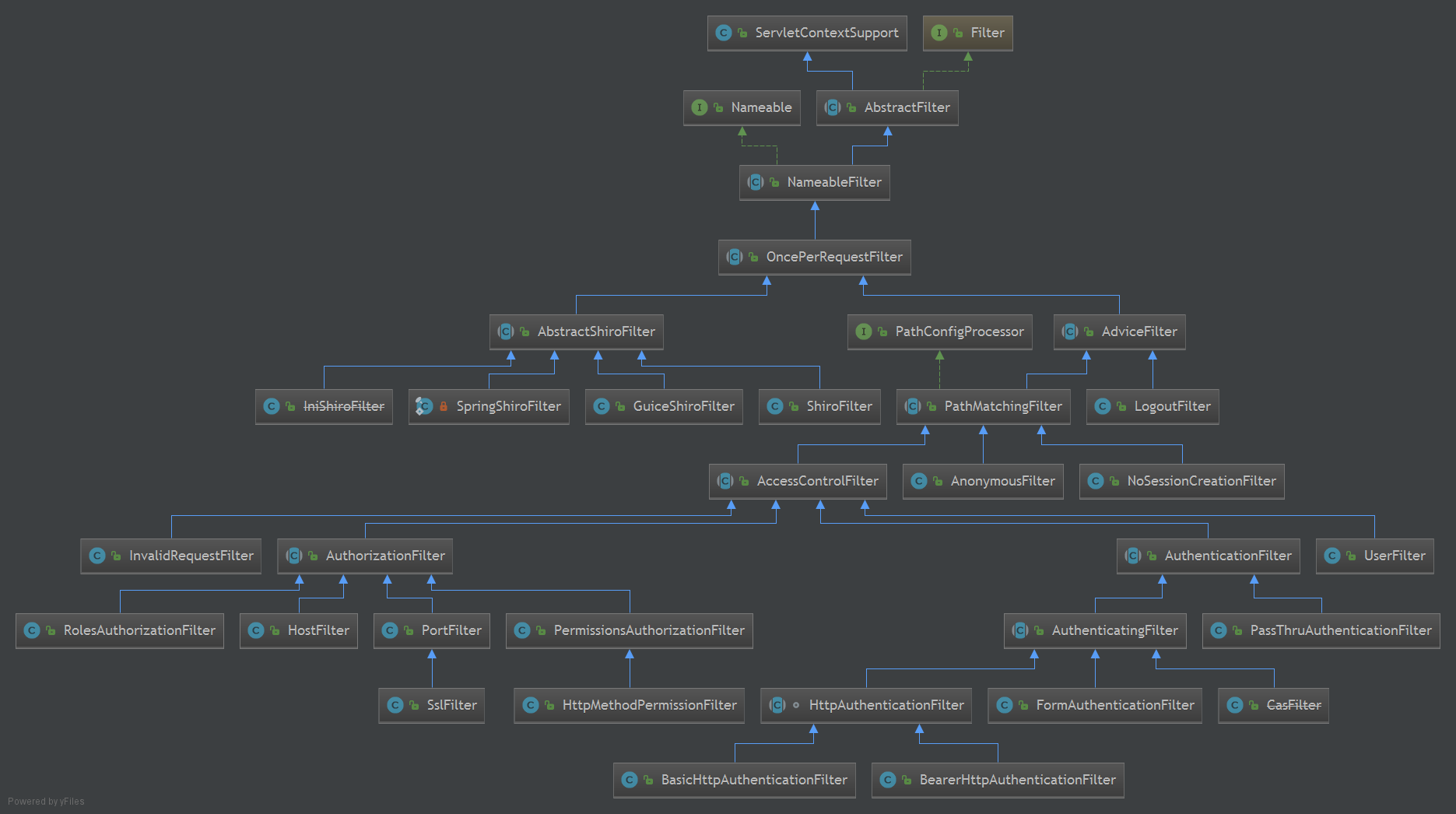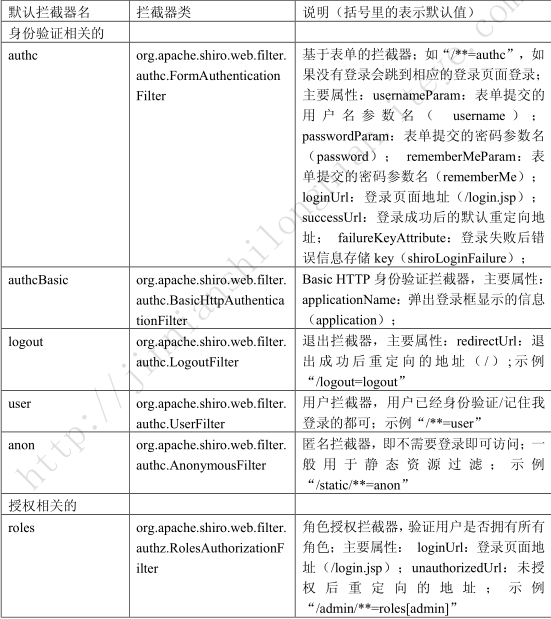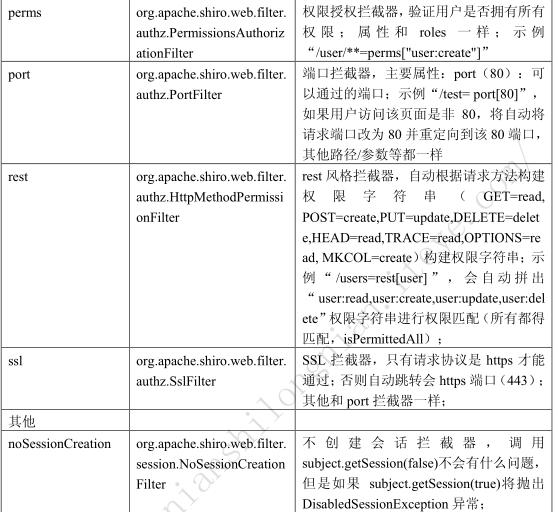apahce shiro:1.6.0,依赖shiro-web部分
一、shiro与web集成
1、Shiro1.1 及以前版本配置方式
使用org.apache.shiro.web.servlet.IniShiroFilter作为Shiro安全控制的入口点。
web.xml:

<?xml version="1.0" encoding="UTF-8"?> <web-app xmlns="http://java.sun.com/xml/ns/javaee" xmlns:xsi="http://www.w3.org/2001/XMLSchema-instance" xsi:schemaLocation="http://java.sun.com/xml/ns/javaee http://java.sun.com/xml/ns/javaee/web-app_3_0.xsd" version="3.0" metadata-complete="false"> <!--- shiro 1.1 --> <filter> <filter-name>iniShiroFilter</filter-name> <filter-class>org.apache.shiro.web.servlet.IniShiroFilter</filter-class> <init-param> <param-name>configPath</param-name> <param-value>classpath:shiro.ini</param-value> <!--默认先从/WEB-INF/shiro.ini,如果没有找classpath:shiro.ini--> </init-param> <init-param> <param-name>config</param-name> <param-value> [main] authc.loginUrl=/login [users] zhang=123,admin [roles] admin=user:*,menu:* [urls] /login=anon /static/**=anon /authenticated=authc /role=authc,roles[admin] /permission=authc,perms["user:create"] </param-value> </init-param> </filter> <filter-mapping> <filter-name>iniShiroFilter</filter-name> <url-pattern>/*</url-pattern> </filter-mapping> <error-page> <error-code>401</error-code> <location>/WEB-INF/jsp/unauthorized.jsp</location> </error-page> </web-app>
2、Shiro 1.2 及以后版本的配置方式
使用org.apache.shiro.web.env.EnvironmentLoaderListener来创建相应的WebEnvironment,并自动绑定到ServletContext,默认使用org.apache.shiro.web.env.IniWebEnvironment实现。
web.xml:

<?xml version="1.0" encoding="UTF-8"?> <web-app xmlns="http://java.sun.com/xml/ns/javaee" xmlns:xsi="http://www.w3.org/2001/XMLSchema-instance" xsi:schemaLocation="http://java.sun.com/xml/ns/javaee http://java.sun.com/xml/ns/javaee/web-app_3_0.xsd" version="3.0" metadata-complete="false"> <!--- shiro 1.2 --> <listener> <listener-class>org.apache.shiro.web.env.EnvironmentLoaderListener</listener-class> </listener> <context-param> <param-name>shiroEnvironmentClass</param-name> <param-value>org.apache.shiro.web.env.IniWebEnvironment</param-value><!-- 默认先从/WEB-INF/shiro.ini,如果没有找classpath:shiro.ini --> </context-param> <context-param> <param-name>shiroConfigLocations</param-name> <param-value>classpath:shiro.ini</param-value> </context-param> <filter> <filter-name>shiroFilter</filter-name> <filter-class>org.apache.shiro.web.servlet.ShiroFilter</filter-class> </filter> <filter-mapping> <filter-name>shiroFilter</filter-name> <url-pattern>/*</url-pattern> </filter-mapping> </web-app>
3、与Spring集成
使用org.springframework.web.filter.DelegatingFilterProxy作为入口,DelegatingFilterProxy自动到spring容器查找名字为 shiroFilter的bean并把所有 Filter 的操作委托给它。然后将ShiroFilter配置到spring容器即可
目前基本上都是用于spring集成的方式。
web.xml:

<?xml version="1.0" encoding="UTF-8"?> <web-app xmlns="http://java.sun.com/xml/ns/javaee" xmlns:xsi="http://www.w3.org/2001/XMLSchema-instance" xsi:schemaLocation="http://java.sun.com/xml/ns/javaee http://java.sun.com/xml/ns/javaee/web-app_3_0.xsd" version="3.0" metadata-complete="false"> <!-- Spring配置文件开始 --> <context-param> <param-name>contextConfigLocation</param-name> <param-value> classpath:spring-beans.xml, classpath:spring-shiro-web.xml </param-value> </context-param> <listener> <listener-class>org.springframework.web.context.ContextLoaderListener</listener-class> </listener> <!-- Spring配置文件结束 --> <!-- shiro 安全过滤器 --> <!-- The filter-name matches name of a 'shiroFilter' bean inside applicationContext.xml --> <filter> <filter-name>shiroFilter</filter-name> <filter-class>org.springframework.web.filter.DelegatingFilterProxy</filter-class> <async-supported>true</async-supported> <init-param> <param-name>targetFilterLifecycle</param-name> <param-value>true</param-value> </init-param> </filter> <!-- Make sure any request you want accessible to Shiro is filtered. /* catches all --> <!-- requests. Usually this filter mapping is defined first (before all others) to --> <!-- ensure that Shiro works in subsequent filters in the filter chain: --> <filter-mapping> <filter-name>shiroFilter</filter-name> <url-pattern>/*</url-pattern> </filter-mapping> <servlet> <servlet-name>spring</servlet-name> <servlet-class>org.springframework.web.servlet.DispatcherServlet</servlet-class> <init-param> <param-name>contextConfigLocation</param-name> <param-value>classpath:spring-mvc.xml</param-value> </init-param> <load-on-startup>1</load-on-startup> <async-supported>true</async-supported> </servlet> <servlet-mapping> <servlet-name>spring</servlet-name> <url-pattern>/</url-pattern> </servlet-mapping> </web-app>
spring-shiro-web.xml:

<?xml version="1.0" encoding="UTF-8"?> <beans xmlns="http://www.springframework.org/schema/beans" xmlns:util="http://www.springframework.org/schema/util" xmlns:xsi="http://www.w3.org/2001/XMLSchema-instance" xsi:schemaLocation=" http://www.springframework.org/schema/beans http://www.springframework.org/schema/beans/spring-beans.xsd http://www.springframework.org/schema/util http://www.springframework.org/schema/util/spring-util.xsd"> <!-- 缓存管理器 使用Ehcache实现 --> <bean id="cacheManager" class="org.apache.shiro.cache.ehcache.EhCacheManager"> <property name="cacheManagerConfigFile" value="classpath:ehcache.xml"/> </bean> <!-- 凭证匹配器 --> <bean id="credentialsMatcher" class="com.github.zhangkaitao.shiro.chapter12.credentials.RetryLimitHashedCredentialsMatcher"> <constructor-arg ref="cacheManager"/> <property name="hashAlgorithmName" value="md5"/> <property name="hashIterations" value="2"/> <property name="storedCredentialsHexEncoded" value="true"/> </bean> <!-- Realm实现 --> <bean id="userRealm" class="com.github.zhangkaitao.shiro.chapter12.realm.UserRealm"> <property name="userService" ref="userService"/> <property name="credentialsMatcher" ref="credentialsMatcher"/> <property name="cachingEnabled" value="true"/> <property name="authenticationCachingEnabled" value="true"/> <property name="authenticationCacheName" value="authenticationCache"/> <property name="authorizationCachingEnabled" value="true"/> <property name="authorizationCacheName" value="authorizationCache"/> </bean> <!-- 会话ID生成器 --> <bean id="sessionIdGenerator" class="org.apache.shiro.session.mgt.eis.JavaUuidSessionIdGenerator"/> <!-- 会话Cookie模板 --> <bean id="sessionIdCookie" class="org.apache.shiro.web.servlet.SimpleCookie"> <constructor-arg value="sid"/> <property name="httpOnly" value="true"/> <property name="maxAge" value="180000"/> </bean> <!-- 会话DAO --> <bean id="sessionDAO" class="org.apache.shiro.session.mgt.eis.EnterpriseCacheSessionDAO"> <property name="activeSessionsCacheName" value="shiro-activeSessionCache"/> <property name="sessionIdGenerator" ref="sessionIdGenerator"/> </bean> <!-- 会话验证调度器 --> <bean id="sessionValidationScheduler" class="org.apache.shiro.session.mgt.quartz.QuartzSessionValidationScheduler"> <property name="sessionValidationInterval" value="1800000"/> <property name="sessionManager" ref="sessionManager"/> </bean> <!-- 会话管理器 --> <bean id="sessionManager" class="org.apache.shiro.web.session.mgt.DefaultWebSessionManager"> <property name="globalSessionTimeout" value="1800000"/> <property name="deleteInvalidSessions" value="true"/> <property name="sessionValidationSchedulerEnabled" value="true"/> <property name="sessionValidationScheduler" ref="sessionValidationScheduler"/> <property name="sessionDAO" ref="sessionDAO"/> <property name="sessionIdCookieEnabled" value="true"/> <property name="sessionIdCookie" ref="sessionIdCookie"/> </bean> <!-- 安全管理器 --> <bean id="securityManager" class="org.apache.shiro.web.mgt.DefaultWebSecurityManager"> <property name="realm" ref="userRealm"/> <property name="sessionManager" ref="sessionManager"/> <property name="cacheManager" ref="cacheManager"/> </bean> <!-- 相当于调用SecurityUtils.setSecurityManager(securityManager) --> <bean class="org.springframework.beans.factory.config.MethodInvokingFactoryBean"> <property name="staticMethod" value="org.apache.shiro.SecurityUtils.setSecurityManager"/> <property name="arguments" ref="securityManager"/> </bean> <!-- 基于Form表单的身份验证过滤器 --> <bean id="formAuthenticationFilter" class="org.apache.shiro.web.filter.authc.FormAuthenticationFilter"> <property name="usernameParam" value="username"/> <property name="passwordParam" value="password"/> <property name="loginUrl" value="/login.jsp"/> </bean> <!-- Shiro的Web过滤器 --> <bean id="shiroFilter" class="org.apache.shiro.spring.web.ShiroFilterFactoryBean"> <property name="securityManager" ref="securityManager"/> <property name="loginUrl" value="/login.jsp"/> <property name="unauthorizedUrl" value="/unauthorized.jsp"/> <property name="filters"> <util:map> <entry key="authc" value-ref="formAuthenticationFilter"/> </util:map> </property> <property name="filterChainDefinitions"> <value> /index.jsp = anon /unauthorized.jsp = anon /login.jsp = authc /logout = logout /** = user </value> </property> </bean> <!-- Shiro生命周期处理器--> <bean id="lifecycleBeanPostProcessor" class="org.apache.shiro.spring.LifecycleBeanPostProcessor"/> </beans>
二、常用shiro内置拦截器

1、NameableFilter
NameableFilter给Filter起个名字,如果没有设置默认就是FilterName;当我们组装拦截器链时会根据这个名字找到相应的拦截器实例;
2、OncePerRequestFilter
OncePerRequestFilter用于防止多次执行Filter;也就是说一次请求只会走一次拦截器链;另外提供enabled属性,表示是否开启该拦截器实例,默认enabled=true表示开启,如果不想让某个拦截器工作,可以设置为false即可。
3、ShiroFilter
ShiroFilter是整个Shiro的入口点,用于拦截需要安全控制的请求进行处理。
4、AdviceFilter
AdviceFilter提供了AOP风格的支持,类似于SpringMVC中的Interceptor.
5、PathMatchingFilter
PathMatchingFilter 提供了基于Ant风格的请求路径匹配功能及拦截器参数解析的功能,如"roles[admin,user]"自动根据","分割解析到一个路径参数配置并绑定到相应的路径:
6、AccessControlFilter
AccessControlFilter提供了访问控制的基础功能;比如是否允许访问/当访问拒绝时如何处理等
7、默认拦截器
org.apache.shiro.web.filter.mgt.DefaultFilter 中的枚举拦截器
public enum DefaultFilter { anon(AnonymousFilter.class), authc(FormAuthenticationFilter.class), authcBasic(BasicHttpAuthenticationFilter.class), authcBearer(BearerHttpAuthenticationFilter.class), logout(LogoutFilter.class), noSessionCreation(NoSessionCreationFilter.class), perms(PermissionsAuthorizationFilter.class), port(PortFilter.class), rest(HttpMethodPermissionFilter.class), roles(RolesAuthorizationFilter.class), ssl(SslFilter.class), user(UserFilter.class), invalidRequest(InvalidRequestFilter.class); }


8、自定义拦截器
通过自定义自己的拦截器可以扩展一些功能,诸如动态 url-角色/权限访问控制的实现、根据 Subject 身份信息获取用户信息绑定到 Request(即设置通用数据)、验证码验证、在线用户信息的保存等等,因为其本质就是一个 Filter;所以 Filter 能做的它就能做.
(1)默认拦截器接口定义有三个方法
public interface Filter { //初始化 void init(FilterConfig var1) throws ServletException; //执行拦截逻辑 void doFilter(ServletRequest var1, ServletResponse var2, FilterChain var3) throws IOException, ServletException; //拦截器销毁回调方法 void destroy(); }
(2)根据需要继承相应的父类 重写相应方法即可
如果我们想进行访问控制就可以继承AccessControlFilter;
如果我们要添加一些通用数据我们可以直接继承PathMatchingFilter;
三、拦截器链
Shiro对Servlet容器的FilterChain进行了代理,即ShiroFilter在继续 Servlet 容器的 Filter链的执行之前,通过 ProxiedFilterChain 对 Servlet 容器的 FilterChain 进行了代理;即先走
Shiro 自己的 Filter 体系,然后才会委托给 Servlet 容器的 FilterChain 进行 Servlet 容器级别的 Filter 链执行; Shiro 的 ProxiedFilterChain 执行流程: 1、 先执行 Shiro 自己的 Filter 链; 2、再执行 Servlet 容器的 Filter 链(即原始的 Filter)。
1、拦截器链管理器
接口FilterChainManager,用于注册 Filter;注册 URL-Filter 的映射关系。

public interface FilterChainManager { //返回注册当当前FilterChainManager过滤器 Map<String, Filter> getFilters(); //根据过滤器链名称返回过滤器链 NamedFilterList getChain(String chainName); //校验是否有可用的过滤器链 boolean hasChains(); //返回所有过滤器链的名称 Set<String> getChainNames(); //输入一个源过滤器链返回一个名字为chainName的代理过滤器链 //交给SimpleNamedFilterList代理最终包装成一个ProxiedFilterChain返回 FilterChain proxy(FilterChain original, String chainName); //注册过滤器 void addFilter(String name, Filter filter); //注册过滤器 添加之前是否要初始化 void addFilter(String name, Filter filter, boolean init); //根据给定的名字和格式字符串定义创建过滤器链 void createChain(String chainName, String chainDefinition); //对于没有匹配到的请求路径 通常是/** 创建一个默认过滤器链 void createDefaultChain(String chainName); //注册 URL-Filter 的映射关系 void addToChain(String chainName, String filterName); void addToChain(String chainName, String filterName, String chainSpecificFilterConfig) throws ConfigurationException; //配置一个全局的过滤器集合用于所有请求路径 这个集合将先于创建和设置过滤器链之前匹配 void setGlobalFilters(List<String> globalFilterNames) throws ConfigurationException; }
实现类DefaultFilterChainManager在构造器中会默认添加org.apache.shiro.web.filter.mgt.DefaultFilter中声明的拦截器。
(1)shiro1.2注册拦截器的流程?
应用启动时:
监听器org.apache.shiro.web.env.EnvironmentLoaderListener -->org.apache.shiro.web.env.EnvironmentLoader -->org.apache.shiro.web.env.IniWebEnvironment(默认是IniWebEnvironment,可以配置成自定义的类) -->默认加载classpath:shiro.ini文件进行解析 -->创建web安全管理器WebSecurityManager -->IniFilterChainResolverFactory::createInstance通过IniFilterChainResolverFactory工厂创建拦截器链处理器,默认是PathMatchingFilterChainResolver -->PathMatchingFilterChainResolver::getFilterChainManager获取拦截器链管理器DefaultFilterChainManager -->IniFilterChainResolverFactory::buildChains创建过滤器链 -->IniFilterChainResolverFactory::registerFilters-->DefaultFilterChainManager::addFilter注册过滤器存放到LinkedHashMap<String, Filter>结构 -->IniFilterChainResolverFactory::createChains-->DefaultFilterChainManager::createChain创建过滤器链 url部分是chainname存放到LinkedHashMap<String, NamedFilterList>结构
如果要自定义FilterChainResolver,可以自定义MyIniWebEnvironment.java继承IniWebEnvironment来重写上面逻辑
MyIniWebEnvironment.java:

package com.github.zhangkaitao.shiro.chapter8.web.env; import org.apache.shiro.util.ClassUtils; import org.apache.shiro.web.env.IniWebEnvironment; import org.apache.shiro.web.filter.authc.FormAuthenticationFilter; import org.apache.shiro.web.filter.authz.RolesAuthorizationFilter; import org.apache.shiro.web.filter.mgt.DefaultFilter; import org.apache.shiro.web.filter.mgt.DefaultFilterChainManager; import org.apache.shiro.web.filter.mgt.FilterChainResolver; import org.apache.shiro.web.filter.mgt.PathMatchingFilterChainResolver; import javax.servlet.Filter; public class MyIniWebEnvironment extends IniWebEnvironment { @Override protected FilterChainResolver createFilterChainResolver() { //在此处扩展自己的FilterChainResolver //1、创建FilterChainResolver PathMatchingFilterChainResolver filterChainResolver = new PathMatchingFilterChainResolver(); //2、创建FilterChainManager DefaultFilterChainManager filterChainManager = new DefaultFilterChainManager(); //3、注册Filter for(DefaultFilter filter : DefaultFilter.values()) { filterChainManager.addFilter(filter.name(), (Filter) ClassUtils.newInstance(filter.getFilterClass())); } //4、注册URL-Filter的映射关系 filterChainManager.addToChain("/login.jsp", "authc"); filterChainManager.addToChain("/unauthorized.jsp", "anon"); filterChainManager.addToChain("/**", "authc"); filterChainManager.addToChain("/**", "roles", "admin"); //5、设置Filter的属性 FormAuthenticationFilter authcFilter = (FormAuthenticationFilter)filterChainManager.getFilter("authc"); authcFilter.setLoginUrl("/login.jsp"); RolesAuthorizationFilter rolesFilter = (RolesAuthorizationFilter)filterChainManager.getFilter("roles"); rolesFilter.setUnauthorizedUrl("/unauthorized.jsp"); filterChainResolver.setFilterChainManager(filterChainManager); return filterChainResolver; } }
web.xml:

<?xml version="1.0" encoding="UTF-8"?> <web-app xmlns="http://java.sun.com/xml/ns/javaee" xmlns:xsi="http://www.w3.org/2001/XMLSchema-instance" xsi:schemaLocation="http://java.sun.com/xml/ns/javaee http://java.sun.com/xml/ns/javaee/web-app_3_0.xsd" version="3.0" metadata-complete="false"> <!--- shiro 1.2 --> <listener> <listener-class>org.apache.shiro.web.env.EnvironmentLoaderListener</listener-class> </listener> <context-param> <param-name>shiroEnvironmentClass</param-name> <param-value>com.github.zhangkaitao.shiro.chapter8.web.env.MyIniWebEnvironment</param-value> </context-param> <context-param> <param-name>shiroConfigLocations</param-name> <param-value>classpath:shiro.ini</param-value> </context-param> <filter> <filter-name>shiroFilter</filter-name> <filter-class>org.apache.shiro.web.servlet.ShiroFilter</filter-class> </filter> <filter-mapping> <filter-name>shiroFilter</filter-name> <url-pattern>/*</url-pattern> </filter-mapping> </web-app>
(2)shiro与spring整合注册拦截器的流程?
结合一个整合Spring的web.xml配置来回顾一下web.xml各组件的启动顺序以及访问时的执行顺序:

<?xml version="1.0" encoding="UTF-8"?> <web-app xmlns="http://java.sun.com/xml/ns/javaee" xmlns:xsi="http://www.w3.org/2001/XMLSchema-instance" xsi:schemaLocation="http://java.sun.com/xml/ns/javaee http://java.sun.com/xml/ns/javaee/web-app_3_0.xsd" version="3.0" metadata-complete="false"> <!-- Spring配置文件开始 --> <context-param> <param-name>contextConfigLocation</param-name> <param-value> classpath:spring-beans.xml, classpath:spring-shiro-web.xml </param-value> </context-param> <listener> <listener-class>org.springframework.web.context.ContextLoaderListener</listener-class> </listener> <!-- Spring配置文件结束 --> <!-- shiro 安全过滤器 --> <!-- The filter-name matches name of a 'shiroFilter' bean inside applicationContext.xml --> <filter> <filter-name>shiroFilter</filter-name> <filter-class>org.springframework.web.filter.DelegatingFilterProxy</filter-class> <async-supported>true</async-supported> <init-param> <param-name>targetFilterLifecycle</param-name> <param-value>true</param-value> </init-param> </filter> <!-- Make sure any request you want accessible to Shiro is filtered. /* catches all --> <!-- requests. Usually this filter mapping is defined first (before all others) to --> <!-- ensure that Shiro works in subsequent filters in the filter chain: --> <filter-mapping> <filter-name>shiroFilter</filter-name> <url-pattern>/*</url-pattern> </filter-mapping> <servlet> <servlet-name>spring</servlet-name> <servlet-class>org.springframework.web.servlet.DispatcherServlet</servlet-class> <init-param> <param-name>contextConfigLocation</param-name> <param-value>classpath:spring-mvc.xml</param-value> </init-param> <load-on-startup>1</load-on-startup> <async-supported>true</async-supported> </servlet> <servlet-mapping> <servlet-name>spring</servlet-name> <url-pattern>/</url-pattern> </servlet-mapping> </web-app>
启动顺序:先执行监听器public void contextInitialized(ServletContextEvent event)方法,然后执行拦截器Filter的public void init()方法
用户访问执行顺序:先执行拦截器filter的doFilter方法,在执行Servlet的doGet/doPost/service方法;
流程:
Spring监听器org.springframework.web.context.ContextLoaderListener::contextInitialized -->org.springframework.web.context.ContextLoader::initWebApplicationContext加载spring-beans.xml、spring-shiro-web.xml注册bean到Spring容器上下文 -->spring-shiro-web.xml初始化和shiro相关的各个类,这里看一下Shiro的Web过滤器shiroFilter,实现类是org.apache.shiro.spring.web.ShiroFilterFactoryBean -->org.apache.shiro.spring.web.ShiroFilterFactoryBean::createInstance创建SecurityManager、FilterChainManager、PathMatchingFilterChainResolver,返回SpringShiroFilter实例,和原生ShiroFilter一样要继承AbstractShiroFilter -->org.apache.shiro.spring.web.ShiroFilterFactoryBean::createFilterChainManager在创建过滤器链管理器时将过滤器、过滤器链注册到过滤器链管理器 拦截器:org.springframework.web.filter.DelegatingFilterProxy::init没有重写init 则执行父类的init方法 -->org.springframework.web.filter.GenericFilterBean::init -->org.springframework.web.filter.DelegatingFilterProxy::initFilterBean这一步是获取web.xml中配置的<filter-name>内容 也就是shiroFilter 赋值给targetBeanName -->org.springframework.web.filter.DelegatingFilterProxy::initDelegate这一步很重要就是根据targetBeanName将之前注册好的ShiroFilter赋值给DelegatingFilterProxy里的delegate
2、拦截器链处理器
接口FilterChainResolver:解析请求url,然后将URL和拦截器链管理器存放的拦截器链模式匹配,根据传入原始的chain得到一个代理的chain,默认包装成ProxiedFilterChain
public interface FilterChainResolver { FilterChain getChain(ServletRequest request, ServletResponse response, FilterChain originalChain); }
默认实现类:PathMatchingFilterChainResolver:按照Ant风格路径匹配的处理器
(1)shiro1.2执行拦截器链的流程?
web.xml配置的入口filter是org.apache.shiro.web.servlet.ShiroFilter,会执行doFilter方法,ShiroFilter本身没有实现doFilter方法,则向上执行父类的doFilter方法: 请求url-->org.apache.shiro.web.servlet.ShiroFilter::doFilter方法 -->org.apache.shiro.web.servlet.OncePerRequestFilter::doFilter方法 -->org.apache.shiro.web.servlet.AbstractShiroFilter::doFilterInternal组装Subject -->org.apache.shiro.subject.subject::execute -->org.apache.shiro.web.servlet.AbstractShiroFilter::executeChain -->org.apache.shiro.web.servlet.AbstractShiroFilter::getExecutionChain -->PathMatchingFilterChainResolver::getChain在这里根据请求地址获取对应代理拦截器链 -->ProxiedFilterChain::doFilter依次执行拦截器链上的拦截器
(2)shiro与Spring整合执行拦截器链的流程?
拦截器:org.springframework.web.filter.DelegatingFilterProxy::doFilter -->org.springframework.web.filter.DelegatingFilterProxy::invokeDelegate 这里delegate就是注入的ShiroFilter -->org.apache.shiro.spring.web.ShiroFilterFactoryBean.SpringShiroFilter::doFilter没有重写 调用父类doFilter方法 -->org.apache.shiro.web.servlet.OncePerRequestFilter::doFilter方法 -->org.apache.shiro.web.servlet.AbstractShiroFilter::doFilterInternal组装Subject -->org.apache.shiro.subject.subject::execute -->org.apache.shiro.web.servlet.AbstractShiroFilter::executeChain -->org.apache.shiro.web.servlet.AbstractShiroFilter::getExecutionChain -->PathMatchingFilterChainResolver::getChain在这里根据请求地址获取对应代理拦截器链 -->ProxiedFilterChain::doFilter依次执行拦截器链上的拦截器
3、拦截器链
javax.servlet.FilterChain:拦截器链接口,里面就一个方法执行拦截器
public interface FilterChain { void doFilter(ServletRequest var1, ServletResponse var2) throws IOException, ServletException; }
shiro里的实现:ProxiedFilterChain.java
public class ProxiedFilterChain implements FilterChain { private static final Logger log = LoggerFactory.getLogger(ProxiedFilterChain.class); private FilterChain orig; private List<Filter> filters; private int index = 0; //构造拦截器链 public ProxiedFilterChain(FilterChain orig, List<Filter> filters) { if (orig == null) { throw new NullPointerException("original FilterChain cannot be null."); } this.orig = orig; this.filters = filters; this.index = 0; } //依次执行list中拦截器 public void doFilter(ServletRequest request, ServletResponse response) throws IOException, ServletException { if (this.filters == null || this.filters.size() == this.index) { //当执行完拦截器链中所有拦截器后 然后执行元拦截器链中拦截器 this.orig.doFilter(request, response); } else { //顺序执行拦截器链中的拦截器 this.filters.get(this.index++).doFilter(request, response, this); } } }
代码及内容参考:张开涛-跟我学shiro
